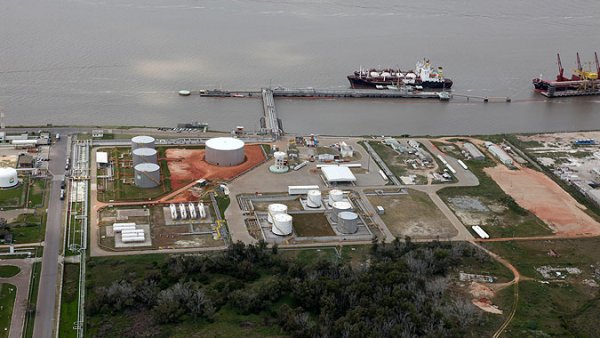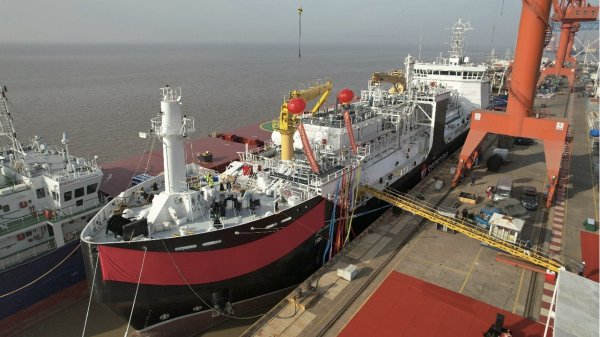First fuel oil cargo for Ust-Luga terminal
44,000-tonne lot is the first cargo of hydrocarbons to be loaded from Ust-Luga's new oil product terminal.
The product carrier SCF Neva, owned by Sovcomflot, was the first vessel to load fuel oil from the new oil product terminal at the Russian port of Ust-Luga, located in the Leningrad Region.
On 31 January 2011, the ice class 1A SCF Neva, with a cargo of 44,000 tonnes of fuel oil, departed from Ust-Luga heading for the port of Tallinn, Estonia.
Viktor Olersky, Deputy Russian Transport Minister, confirmed that OJSC Rosneftbunker, was responsible for shipping the cargo.
"The receipt at Ust-Luga of the first, albeit in testing mode, tanker symbolizes the launch of a new export route for Russian oil products. I'm confident that it will take on some of the cargo flow that today moves through Baltic ports, primarily though Estonian terminals," said Olersky.
Safe mooring of the tanker was made possible via use of the tugs Stavr, Dobrynya and Dunai - all three operated by Rosnefteflot, a joint venture between Sovcomflot and Rosneft. The tugs are said to have been specially designed and constructed to work in the ports of the Northwest Region of the Russian Federation.
Commenting on the loading operation, Andrey Babahanov, director of fleet operations for OAO Sovcomflot, said: "Successful loading of fuel oil aboard the tanker SCF Neva on 31 January is a trial operation. In close coordination with the cargo owners and the port operators, we needed to check the functioning of all services and systems of Russia's new oil products terminal. The data obtained during the handling of the tanker SCF Neva will be taken into account when the loading of large tankers is arranged in the port of Ust-Luga."
The official opening ceremony of the new oil products terminal is scheduled to take place during the first quarter of 2011.
On 31 January 2011, the ice class 1A SCF Neva, with a cargo of 44,000 tonnes of fuel oil, departed from Ust-Luga heading for the port of Tallinn, Estonia.
Viktor Olersky, Deputy Russian Transport Minister, confirmed that OJSC Rosneftbunker, was responsible for shipping the cargo.
"The receipt at Ust-Luga of the first, albeit in testing mode, tanker symbolizes the launch of a new export route for Russian oil products. I'm confident that it will take on some of the cargo flow that today moves through Baltic ports, primarily though Estonian terminals," said Olersky.
Safe mooring of the tanker was made possible via use of the tugs Stavr, Dobrynya and Dunai - all three operated by Rosnefteflot, a joint venture between Sovcomflot and Rosneft. The tugs are said to have been specially designed and constructed to work in the ports of the Northwest Region of the Russian Federation.
Commenting on the loading operation, Andrey Babahanov, director of fleet operations for OAO Sovcomflot, said: "Successful loading of fuel oil aboard the tanker SCF Neva on 31 January is a trial operation. In close coordination with the cargo owners and the port operators, we needed to check the functioning of all services and systems of Russia's new oil products terminal. The data obtained during the handling of the tanker SCF Neva will be taken into account when the loading of large tankers is arranged in the port of Ust-Luga."
The official opening ceremony of the new oil products terminal is scheduled to take place during the first quarter of 2011.

|
IMO approves pricing mechanism based on GHG intensity thresholds
Charges to be levied on ships that do not meet yearly GHG fuel intensity reduction targets. |
|
|
|
||

|
VARO Energy expands renewable portfolio with Preem acquisition
All-cash transaction expected to complete in the latter half of 2025. |
|
|
|
||

|
NYK trials biofuel in milestone coal carrier test
Vessel is used to test biofuel for domestic utility company. |
|
|
|
||

|
H-Line Shipping orders LNG bunkering vessel
Vessel with 18,000-cbm capacity to run on both LNG and MDO. |
|
|
|
||

|
How to engineer and manage green shipping fuels | Stanley George, VPS
Effective management strategies and insights for evolving fuel use. |
|
|
|
||

|
Swedish government bans scrubber wastewater discharges
Discharges from open-loop scrubbers to be prohibited in Swedish waters from July 2025. |
|
|
|
||

|
MAN Energy Solutions achieves 100% load milestone for ammonia engine
Latest tests validate fuel injection system throughout the entire load curve. |
|
|
|
||

|
Petrobras secures ISCC EU RED certification for B24 biofuel blend at Rio Grande
Blend consisting of 24% FAME is said to have been rigorously tested to meet international standards. |
|
|
|
||

|
Stolt-Nielsen to fully control Avenir LNG with acquisition
Share purchase agreement to buy all shares from Golar LNG and Aequitas. |
|
|
|
||

|
Bureau Veritas supports launch of CIMC SOE's LNG bunkering vessel
Handover of Seaspan Energy's cutting-edge 7,600-cbm vessel completed. |
|
|
|
||
Related Links
- · $200m credit line for Rosneftbunker [Insights]
- · Ust-Luga: LPG terminal construction underway [Insights]
- · Russia raises fuel oil tax by 32.7% [Insights]
- · Russia [Directory]
- · Ust-Luga [Directory]

